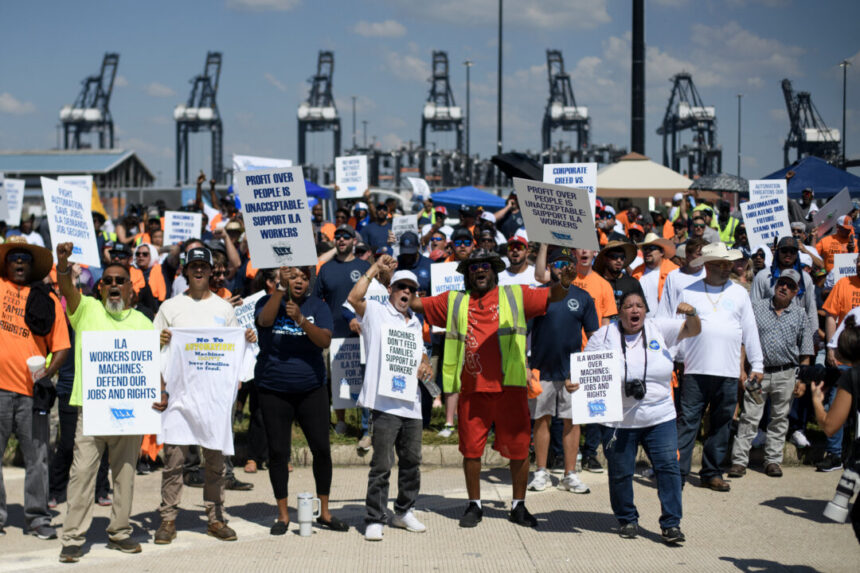After the third day of the strike, thousands of port workers are heading back to work.
Tens of thousands of dock and port workers are heading back to work after their union and the United States Maritime Alliance (USMX) reached a tentative agreement ending the labor dispute on Oct. 3.
The International Longshoremen’s Association (ILA), North America’s largest union of maritime workers, including 85,000 dock and port workers, established a provisional wage deal with the USMX.
The breakthrough came after port employers reportedly offered a 62 percent wage increase over six years. The agreement also extends their master contract to add more time to iron out details over a new contract.
“The International Longshoremen’s Association and the United States Maritime Alliance, Ltd. have reached a tentative agreement on wages and have agreed to extend the Master Contract until January 15, 2025 to return to the bargaining table to negotiate all other outstanding issues,” ILA and USMX officials said in a joint statement.
All current job action will stop immediately, and as many as 50,000 maritime workers will return to work on Oct. 4.
For the first time in nearly 50 years, the United States witnessed the largest shutdown of Atlantic and Gulf Coast ports.
At midnight on Oct. 1, tens of thousands of dock and port workers from Maine to Texas went on strike. The ILA had rejected the offer from USMX of a nearly 50 percent wage increase, improved retirement benefits, and enhanced automation and semi-automation protections.
Work stoppages were estimated to affect billions in daily trade volumes. ILA president Harold Daggett earlier said the union was “prepared to fight as long as necessary”
Economists projected that a week- or month-long disruption could have harmed the economy and potentially rekindle inflationary pressures.
Grace Zwemmer, the associate U.S. economist at Oxford Economics, estimated the strike would trim GDP growth by as much as 0.13 percent, or $7.5 billion, for each week.
As for inflation, U.S. businesses and consumers were worried about higher prices. The ports handle between 35 and 49 percent of all U.S. imports and exports, with the ports of New York-New Jersey and Houston-Galveston handling a substantial share of these shipments.
Industry leaders have been urging President Joe Biden to intervene by invoking the 1947 Taft-Hartley Act. This would have allowed the White House to file a court order and institute an 80-day cooling-off period, allowing both sides to return to the negotiating table.
“Americans experienced the pain of delays and shortages of goods during the pandemic-era supply chain backlogs in 2021,” said Suzanne Clark, the president of the U.S. Chamber of Commerce, in a letter to the president. “It would be unconscionable to allow a contract dispute to inflict such a shock to our economy.”
President Joe Biden welcomed the announcement.
“Today’s tentative agreement on a record wage and an extension of the collective bargaining process represents critical progress towards a strong contract,” he said in a statement. “I congratulate the dockworkers from the ILA, who deserve a strong contract after sacrificing so much to keep our ports open during the pandemic. And I applaud the port operators and carriers who are members of the US Maritime Alliance for working hard and putting a strong offer on the table.”
The White House had repeatedly indicated that it would not intervene, urging the ILA and USMX to engage in contract talks and negotiate in good faith.
Can you please rephrase this?
Source link







